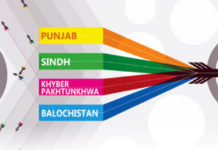The government has stated that the debt to GDP ratio will be reduced to 69.1 percent in the next fiscal year from existing 72.4 percent on the back of fiscal consolidation efforts.
The Medium-Term Budget Strategy Paper released by the Finance Ministry noted that the primary objective of the strategy paper is to facilitate medium term policy-formulation based on reliable projections of revenue and expenditure.
The framework also highlights the fiscal balance and primary balance of the federal and general government.
In order to project overall fiscal balance, estimated levels of provincial surpluses have also been worked out. Over the medium-term, growth is expected to return to levels even higher than historical trends with average rates of 6.0 percent in fiscal year 2024-25.
The debt to GDP ratio will increase and record at around 72.4 percent at the end of ongoing fiscal year (FY22) and is expected to reduce to 69.1 percent in the next fiscal year (FY23) on the back of fiscal consolidation efforts of the government.
Over the medium term, the government’s objective is to bring and maintain its Public Debt-to-GDP ratio to sustainable levels through a combination of greater revenue mobilization, rationalization of current expenditure, and efficient/productive utilization of debt.
Government also aims to reduce its “Gross Financing Needs (GFN)” through various measures mainly including better cash flow management through a treasury single account, lengthening of maturities in the domestic market keeping in view cost and risks trade-off, developing regular Islamic based lending program and avail maximum available concessional external financing from bilateral and multilateral development partners to benefit from concessional terms and conditions.
The government will also try to reduce deficits to restore fiscal sustainability in the medium to long term because the fiscal deficit is the key driver of macroeconomic instability in Pakistan.
The budget 2022-23 will aim to move away from untargeted subsidies to create fiscal space to protect the poor from inflation against CPI inflation which was recorded during July-March 2022 at 10.8 percent as against 8.3 percent during the same period last year.
The government will take all possible measures to contain the current surge of inflation. However, given the worldwide environment, bringing current inflation down will require some time and should not come at the cost of a recession. Therefore, the government plans to divert resources from un-targeted subsidies towards protection of the poor.
These subsidies will be tailor made to provide relief to the poor in difficult times and the government will continue with the social protection programme through greater funding for BISP.
The major fiscal challenge being faced by the Federal Government since the introduction of the 18th constitutional amendment and 7th NFC Award is transfer of 57.5 percent of divisible pool taxes and the straight transfers to the provinces, constituting almost 59.7 percent of the gross federal revenues, which leaves very limited fiscal space for current and development spending for the Federal Government, therefore, the government will work on the new NFC Award in accordance with the provisions of Constitution of Pakistan as it is high time to consider sharing of expenditures on social sector and other subjects including health, education, agriculture and community development with the provincial governments. Federal PSDP shall focus on core strategic national level development projects only.
This Medium-Term Budget Strategy Paper being presented under the provisions of the Public Finance Management Act 2019 reaffirms the commitment of the Federal Government to implement the principles of transparency, responsiveness, inclusiveness, and better financial management during the ensuing three years.






















